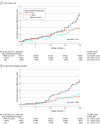Sugar-Sweetened and Artificially Sweetened Beverages and Risk of Liver Cancer and Chronic Liver Disease Mortality
- PMID: 37552302
- PMCID: PMC10410478
- DOI: 10.1001/jama.2023.12618
Sugar-Sweetened and Artificially Sweetened Beverages and Risk of Liver Cancer and Chronic Liver Disease Mortality
Abstract
Importance: Approximately 65% of adults in the US consume sugar-sweetened beverages daily.
Objective: To study the associations between intake of sugar-sweetened beverages, artificially sweetened beverages, and incidence of liver cancer and chronic liver disease mortality.
Design, setting, and participants: A prospective cohort with 98 786 postmenopausal women aged 50 to 79 years enrolled in the Women's Health Initiative from 1993 to 1998 at 40 clinical centers in the US and were followed up to March 1, 2020.
Exposures: Sugar-sweetened beverage intake was assessed based on a food frequency questionnaire administered at baseline and defined as the sum of regular soft drinks and fruit drinks (not including fruit juice); artificially sweetened beverage intake was measured at 3-year follow-up.
Main outcomes and measures: The primary outcomes were (1) liver cancer incidence, and (2) mortality due to chronic liver disease, defined as death from nonalcoholic fatty liver disease, liver fibrosis, cirrhosis, alcoholic liver diseases, and chronic hepatitis. Cox proportional hazards regression models were used to estimate multivariable hazard ratios (HRs) and 95% CIs for liver cancer incidence and for chronic liver disease mortality, adjusting for potential confounders including demographics and lifestyle factors.
Results: During a median follow-up of 20.9 years, 207 women developed liver cancer and 148 died from chronic liver disease. At baseline, 6.8% of women consumed 1 or more sugar-sweetened beverage servings per day, and 13.1% consumed 1 or more artificially sweetened beverage servings per day at 3-year follow-up. Compared with intake of 3 or fewer servings of sugar-sweetened beverages per month, those who consumed 1 or more servings per day had a significantly higher risk of liver cancer (18.0 vs 10.3 per 100 000 person-years [P value for trend = .02]; adjusted HR, 1.85 [95% CI, 1.16-2.96]; P = .01) and chronic liver disease mortality (17.7 vs 7.1 per 100 000 person-years [P value for trend <.001]; adjusted HR, 1.68 [95% CI, 1.03-2.75]; P = .04). Compared with intake of 3 or fewer artificially sweetened beverages per month, individuals who consumed 1 or more artificially sweetened beverages per day did not have significantly increased incidence of liver cancer (11.8 vs 10.2 per 100 000 person-years [P value for trend = .70]; adjusted HR, 1.17 [95% CI, 0.70-1.94]; P = .55) or chronic liver disease mortality (7.1 vs 5.3 per 100 000 person-years [P value for trend = .32]; adjusted HR, 0.95 [95% CI, 0.49-1.84]; P = .88).
Conclusions and relevance: In postmenopausal women, compared with consuming 3 or fewer servings of sugar-sweetened beverages per month, those who consumed 1 or more sugar-sweetened beverages per day had a higher incidence of liver cancer and death from chronic liver disease. Future studies should confirm these findings and identify the biological pathways of these associations.
Conflict of interest statement
Figures


Comment in
-
Risk Factors for Liver Cancer and Chronic Liver Disease-related Death: Are Sugar Substitutes Better Than the Real Thing?Gastroenterology. 2024 Jan;166(1):213-214. doi: 10.1053/j.gastro.2023.09.032. Epub 2023 Sep 24. Gastroenterology. 2024. PMID: 37751781 No abstract available.
-
Sugar-Sweetened Beverages and Risk of Liver Disease.JAMA. 2023 Dec 12;330(22):2217-2218. doi: 10.1001/jama.2023.20814. JAMA. 2023. PMID: 38085317 No abstract available.
-
Einfluss süßer Drinks auf die Leber.MMW Fortschr Med. 2024 Sep;166(14):28. doi: 10.1007/s15006-024-4184-9. MMW Fortschr Med. 2024. PMID: 39210116 Review. German. No abstract available.
References
Publication types
MeSH terms
Substances
Grants and funding
LinkOut - more resources
Full Text Sources
Medical

